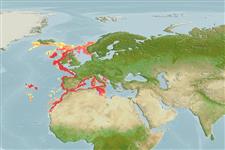>
Eupercaria/misc (Various families in series Eupercaria) >
Sparidae (Porgies)
Etymology: Pagellus: Diminutive of Latin, pager, derived from Greek, pagros = a fish, Dentex sp. (Ref. 45335).
Environment: milieu / climate zone / rango de profundidad / distribution range
Ecología
marino bentopelágico; rango de profundidad 150 - 700 m (Ref. 56504), usually 150 - 300 m (Ref. 35388). Temperate; 65°N - 20°N, 32°W - 37°E
Eastern Atlantic: Norway, Strait of Gibraltar to Cape Blanc in Mauritania, Madeira, Canary Islands, and western Mediterranean (rare beyond the Sicilian Strait). Reported from Iceland (Ref. 12462).
Length at first maturity / Tamaño / Peso / Age
Madurez: Lm 31.4 range ? - ? cm
Max length : 70.0 cm SL macho / no sexado; (Ref. 4781); common length : 30.0 cm SL macho / no sexado; (Ref. 4781); peso máximo publicado: 4.0 kg (Ref. 9987); edad máxima reportada: 15 años (Ref. 4645)
Espinas dorsales (total) : 12 - 13; Radios blandos dorsales (total) : 11 - 13; Espinas anales: 3; Radios blandos anales: 11 - 12. Black spot above the pectoral fin base. Snout shorter than the eye diameter (Ref. 35388).
Body shape (shape guide): fusiform / normal.
Inshore waters above various types of bottom (rocks, sand, mud) to 400 m (Mediterranean) and 700 m (Atlantic); young near the coast, adults on the continental slope specially over muddy bottoms. Omnivorous, but feed mainly on crustaceans, mollusks, worms and small fish. Protandric hermaphrodites, become females at 20-30 cm length. Adults move towards the coast up to the edge of the continental shelf to spawn from January to June (Ref. 3688). Important foodfish. Marketed fresh and frozen; consumed pan-fried, broiled and baked (Ref. 9987).
Protandric hermaphrodite species (male during its first sexual maturity). Becomes female between 2 and 7 years of age. Spawns from January to June, depending on latitude. Egg size 1.19 mm, larval length at hatching 3.7 mm. Simultaneous hermaphroditism is also suggested for this species (Ref. 103751).
Bauchot, M.-L. and J.-C. Hureau, 1990. Sparidae. p. 790-812. In J.C. Quero, J.C. Hureau, C. Karrer, A. Post and L. Saldanha (eds.) Check-list of the fishes of the eastern tropical Atlantic (CLOFETA). JNICT, Lisbon; SEI, Paris; and UNESCO, Paris. Vol. 2. (Ref. 3688)
IUCN Red List Status (Ref. 130435: Version 2025-1)
Threat to humans
Harmless
Human uses
Pesquerías: comercial; pesca deportiva: si
Herramientas
Special reports
Download XML
Fuentes de Internet
Estimates based on models
Preferred temperature (Referencia
123201): 6.9 - 14.9, mean 11.2 °C (based on 160 cells).
Phylogenetic diversity index (Referencia
82804): PD
50 = 0.5156 [Uniqueness, from 0.5 = low to 2.0 = high].
Bayesian length-weight: a=0.01096 (0.00971 - 0.01239), b=3.03 (3.00 - 3.06), in cm total length, based on LWR estimates for this species (Ref.
93245).
Nivel trófico (Referencia
69278): 4.2 ±0.6 se; based on diet studies.
Generation time: 8.5 (6.5 - 9.3) years. Estimated as median ln(3)/K based on 15
growth studies.
Resiliencia (Referencia
120179): Medio, población duplicada en un tiempo mínimo de 1.4-4.4 años (K=0.09-0.1; tmax=15; tm=4-5; Fec=70,000).
Prior r = 0.51, 95% CL = 0.34 - 0.77, Based on 4 full stock assessments.
Fishing Vulnerability (Ref.
59153): High vulnerability (64 of 100).
🛈
Climate Vulnerability (Ref.
125649): Moderate to high vulnerability (45 of 100).
🛈
Nutrients (Ref.
124155): Calcium = 41.2 [17.9, 69.5] mg/100g; Iron = 0.167 [0.103, 0.268] mg/100g; Protein = 19.5 [18.2, 20.8] %; Omega3 = 0.742 [0.486, 1.122] g/100g; Selenium = 47.9 [24.1, 97.4] μg/100g; VitaminA = 10.4 [2.1, 53.0] μg/100g; Zinc = 0.275 [0.208, 0.378] mg/100g (wet weight); based on
nutrient studies.
